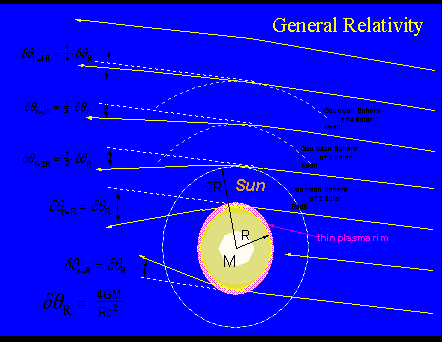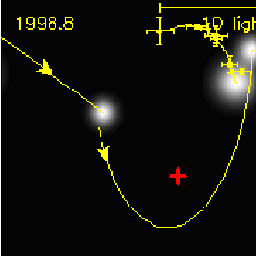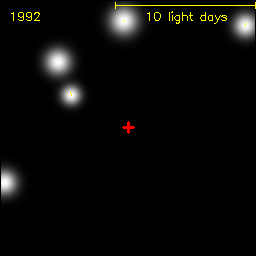"Unthinking respect for authority is the greatest enemy of truth." -Albert EinsteinOf course, all of the above is the "appeal to authority" fallacy, however, it demonstrates that there were in the past scientists who did not fall into lockstep, marching with the orthodox herd shouting "me too," as they all fall off the cliff like the mythical lemmings.Physics New Suit
“Relativity is one of the most well tested theories in science!” And perhaps that is a true statement, but does it reflect the accuracy and usefulness of those tests? Does repeating the same wrong test over and over count? What about the interpretation of the tests, does everyone agree? A little known fact is that Relativity is the only pillar of science still hotly contested in scientific circles even after 100 years of supposed acceptance. While other widely accepted ideas such as Evolution may still be contested, it is always in association with religious beliefs. Relativity’s dissenters share no common religious background or reasoning. Their contentions are purely scientific in nature. Most people’s first thought is, “Surely the people who do not agree are the same group of people insisting congress is populated by aliens”. However, I’d like to introduce you to some of the scientists and inventors who fall in with the dissenters.
How can so many Nobel laureates, inventors and great contributors to society go to their grave believing relativity was false? How could anyone not be convinced all the way into the 50s and 60s? Wasn’t it proven over and over and widely accepted by that time? Isn’t that what we are taught? History is written more by popularity than by fact and unfortunately science occasionally follows suit. There are logical reasons why these great men of science never accepted relativity. There exists very significant experimental evidence against it. Unfortunately, there are far too few people willing to challenge the safety and security afforded them by belief systems. Only those exceedingly strong in mind and of the greatest humility can stand to see that which they held in the highest regard, those things they trusted as universal truth, utterly fail. Only those with the greatest mental fortitude and confidence can become one of the few willing to withstand the onslaught of ridicule and not be swayed by the popularity of popular belief. You have been given the opportunity to examine doubt, while not free from scorn, in very good company. Like the story of 'The Emporer's New Suit', will you be the child that says aloud, “The Emperor is Naked!”? — Source
- Albert A. Michelson: The very first American Nobel prize winner (1907) is also the pioneer of interferometry, which enables the precision guidance of modern weaponry. He received honorary science and law degrees from ten American and foreign universities. He was President of the American Physical Society (1900), the American Association for the Advancement of Science (1910-1911), and the National Academy of Sciences (1923-1927). He was also a Fellow of the Royal Astronomical Society, the Royal Society of London and the Optical Society, an Associate of l'Académie Française and among the many awards he has received are the Matteucci Medal (Societá Italiana), 1904; Copley Medal (Royal Society), 1907; Elliot Cresson Medal (Franklin Institute), 1912; Draper Medal (National Academy of Sciences), 1916; Franklin Medal (Franklin Institute) and the Medal of the Royal Astronomical Society, 1923; and the Duddell Medal (Physical Society), 1929. Though his understanding and experience with the nature and manipulation of light has made vast contributions to our modern world, it is an unfortunate fact that his most widely known contribution to science is the Michelson-Morley experiment of 1887. This experiment is heralded as one of the primary proofs of Relativity yet Michelson never believed relativity to be a tenable theory even to his death in 1931.
- Robert A. Millikan: The second American winner of the Nobel Prize (1923) for his “Oil Drop Experiment” which proved the elementary electronic charge. Millikan's 1916 paper on the measurement of Planck's constant was dramatic in its time but the interpretation was far from the quantum movement caused by relativity. The very first sentence of one of his 1916 papers was “Einstein's photoelectric equation... cannot in my judgment be looked upon at present as resting upon any sort of a satisfactory theoretical foundation" What we now call the photon was, in Millikan's view, "[a] bold, not to say the reckless, hypothesis". In a textbook written by him as late as 1927 he unambiguously supports the existence of ether. Finally, in 1950 at age 82 (3 years before his death), under the barrage of relativity’s mainstream popularity, he somewhat fell in with the majority in his autobiography by stating that his experiments were proof of the photon.
- Louis Essen: Inventor of the atomic clock and the man responsible for the modern precise measurement of the speed of light. At first he suffered harsh criticism for his new measurements of the speed of light but it was the value adopted by the 12th General Assembly of the Radio-Scientific Union in 1957and in 1983, the 17th Conférence Générale des Poids et Mesures adopted the standard value, 299,792.458 km/s for the speed of light. The atomic clock is the standard of measure throughout the world and without it the GPS system would not be possible. Why is it little known that this winner of multiple awards in physics also published a paper called “The Special Theory of Relativity: A Critical Analysis”? A member of the National Physical Laboratory of the UK from which he retired in 1972 after being quietly warned not to continue his contradiction of Einstein’s theory of relativity. "No one has attempted to refute my arguments, but I was warned that if I persisted I was likely to spoil my career prospects. …the continued acceptance and teaching of relativity hinders the development of a rational extension of electromagnetic theory." - Louis Essen F.R.S., "Relativity and time signals", Wireless World, oct78, p44. ‘Students are told that the theory must be accepted although they cannot expect to understand it. They are encouraged right at the beginning of their careers to forsake science in favor of dogma.’
- Ernest Rutherford: 1908 Nobel Prize in Chemistry. His research into radioactive emissions brought forth the notion of an atomic nucleus we know today. While at the Macdonald Laboratory in Montreal, he worked on a “disintegration theory” of radiation. Otto Hahn who later discovered atomic fission, worked under Rutherford at the Montreal Laboratory in 1905-06. By exposing nitrogen to radiation thereby transforming it to an oxygen isotope, he is known as the first person to deliberately transmute one element into another. As the leader of the Cavendish Laboratory, he inspired numerous other Nobel prizewinners to their achievements. C.D. Ellis, his co-author in 1919 and 1930, pointed out "that the majority of the experiments at the Cavendish were really started by Rutherford's direct or indirect suggestion". With awards and medals too numerous to mention; the progenitor of atomic physics he is truly a forefather of modern science. When asked what he thought about relativity he exclaimed "Oh, that stuff! We never bother with that in our work." Stephen Leacock, Common Sense and the Universe Wilhelm Wein: "No Anglo-Saxon can understand relativity!" Ernest Rutherford: "No! they've got too much sense!" From The Rutherford Memorial Lecture to the Physical Society 1954 by P. M. S. Blackett, Year Book of The Physical Society 1955. "The War had just ended; and the complacency of the Edwardian and Victorian times had been shattered. The people felt that all their values and all their ideals had lost their bearings. Now, suddenly, they learnt that an astronomical prediction by a German scientist had been confirmed by expeditions to Brazil and West Africa and, indeed, prepared for already during the War, by British astronomers. Astronomy has always appealed to public imagination; and an astronomical discovery, transcending worldly strife, struck a responsive chord. The meeting of the Royal Society, at which the results of the British expeditions were reported, was headlined in all the British papers; and the typhoon of publicity crossed the Atlantic. From that point on, the American press played Einstein to the maximum." Quotation from: Chandrasekhar S., (1987) Truth and Beauty: Aesthetics and Motivations in Science, University of Chicago press
- Herbert Ives: First transmission (1924) of pictures by wire, resulted in first public demonstration (1927) of television, for which he was awarded (1927) the John Scott Medal. As the lead researcher of Bell Labs’ television development project, he is often known as the father of modern television. As an accomplished physicist, his knowledge and experience in the propagation of light has changed our world. He is also well known for his part in the Ives-Stillwell experiment, which is regularly listed as one of the proofs of relativity. How is it that this individual who participated in this experiment, afterwards wrote numerous papers in peer reviewed journals against relativity? “The 'principle' of the constancy of the velocity of light is not merely 'ununderstandable', it is not supported by 'objective matters of fact'; it is untenable, and, as we shall see, unnecessary. . . . Also of philosophical import is that with the abandonment of the 'principle' of the constancy of the velocity of light, the geometries which have been based on it, with their fusion of space and time, must be denied their claim to be a true description of the physical world." - Herbert E. Ives, "Revisions of the Lorentz Transformations", October 27, 1950
- Ernst Mach: The namesake of the sound barrier, Einstein entitled him as the forerunner of relativity. Most of his studies in the field of experimental physics were devoted to interference, diffraction, polarization and refraction of light in different media under external influences. Though Einstein cited Mach as a source of ideas, Mach rejected Einstein's relativity theory and asked not to be associated with the "dogmatic" and "paradoxical nonsense", in spite of the fact that Joseph Petzoldt sought to give Mach his due credit for major elements of the theory of relativity. Einstein initially adored Mach, and asked for his guidance and help. When it became known, after Mach's death, that Mach rejected Einstein and his views, Einstein ridiculed Mach. “Scientists have now become a church and I do not regard it as an honor to be part of this or of any church.”
- Nikola Tesla: Very likely the greatest inventor of all time and certainly the greatest elecrical engineer of all time. Tesla is most well known for his invention of the AC power distribution system that we still use today. However, he is also responsible for a variety of inventions and patents so wide he could easily be considered to be the single greatest contibuter to the modern age of technology. Just a few of his inventions include the electric motor, radio and wireless communication, electronic logic (the AND gate), the discovery of X-rays, charged particle beams, the rotating magnetic field, flourescent lighting, and the vertical take-off and landing concept. The undeniable link between electricity, magnetism and advanced physics concepts are well known to even laymen. While Relativity is entirely for the purpose of explaining eletromagnetic phenomenon, Tesla, the wizard of electromagnetism who produced so many working useful concepts with his understanding, laughed at the rediculous nature of relativity. ... Supposing that the bodies act upon the surrounding space causing curving of the same, it appears to my simple mind that the curved spaces must react on the bodies, and producing the opposite effects, straightening out the curves. Since action and reaction are coexistent, it follows that the supposed curvature of space is entirely impossible - But even if it existed it would not explain the motions of the bodies, as observed. - "Prepared Statement of Tesla". July 10, 1937. Today's scientists have substituted mathematics for experiments, and they wander off through equation after equation, and eventually build a structure which has no relation to reality. The scientists from Franklin to Morse were clear thinkers and did not produce erroneous theories. The scientists of today think deeply instead of clearly. One must be sane to think clearly, but one can think deeply and be quite insane. - "Radio Power Will Revolutionize the World". Modern Mechanics and Inventions. July, 1934.
There are still such physicists and cosmologists today who challenge the paradigm such as Physicist Dr. Ed Dowdye who asks why the light bends around the Sun's gravity field only when it passes through where the Sun's plasma atmosphere exists, but does not where the plasma atmosphere is absent but there is still a strong gravity field?

The gravitational deflection of light and microwaves propagate along a least timeor minimum energy path
only at the plasma-rim of the sun exposed to the gravitational gradient field of the sun.

Solar light bending as function of the impact parameter R {at solar plasma limb}, 2R, 3R, 4R, etc
"The Observations"
explainable with least-time or minimum-energy waves in
a plasma exposed to solar gravitational gradient field
versus
"General Relativity"
an assumption of space-time effects or curvature of space
to explain gravitational light bending
Relativity Theory states that it should always be distorted because of the gravity field yet all of our empirical data observations show it does not, except where there is a plasma atmosphere. If there is no plasma atmosphere, the light travels on its way, unimpeded, undistorted by gravity. Why? How? The Relativity confirmation data came from the observations that went through the plasma atmosphere. . .
Remarkably as it may seem, however, historically the solar light bending effect has been observed only at the solar rim, the refractive plasma atmosphere of the sun. This is strongly confirmed by a large number of very-long-baseline-interferometer (VLBI) measurements on the gravitational deflection of microwaves from radio pulsar sources that were deflected at the thin plasma rim of the sun at precisely the angle of 1.75 arcsec.The observed solar grazing effect of rays of star light at the thin plasma limb (a thickness that is greatly exaggerated here) is depicted in the following animated illustration:
It is interesting to note that the focal length F of the sun of radius R is determined to be roughly 550 astronomical units (AU's), nearly 14 times the mean orbital radius of Pluto, according to the equation
Where are the thousands of Einstein Rings that should be observed?Animated Image is taken from Nasa — Science NewsThe focal length F and the radius R of the sun are expressed in the same units. As depicted in Figure 7, the light rays from a distant star will come to a focus at a distance of roughly 550 AU's, assuming a convergence angle of 1.75 arcsec. It has been a long desire of many astrophysicists, to include SETI study groups and the International Academy of Astronautics, to send spacecrafts loaded with observational instruments 550 AU's out to the focal point of the solar plasma lens.
If light were to bend around a star's gravitational field forming a gravity lens, then every far field star behind that star would be lensed in front of it in a blurry ring, not a point source because gravity attenuates with distance from the source and the light bends less as you get farther away from the source. . . in other words, the stellar lens is imperfect and will never form a perfect image. The best a gravity lens can produce would be a cloudy ring image around the gravity source forming the lensing. There should be thousands if not millions of Einstein Rings in where ever we look in space, but they are so rare we've found only a handful, if that is what we are seeing at all. In fact, with the sheer number of stars and galaxies in our sky, every star should vice an Einstein Ring, however faint of those objects behind it. However, what lensing is seen is used to explain away high red-shift point source objects that seem to be too close for their velocities. . . and being point sources, they are certainly not Einstein Rings, and could not therefore be artifacts of gravity lenses. So, which is it? Are they impossibly close, or are they impossible gravity lenses forming images that are inexplicable point sources instead of the rings theory predicts?

What we SHOULD be seeing at Sagittarius A circling a massive gravity source, if Gravitational Lensing was occurring.

What we are actually observing at Sagittarius A, circling a massive gravity source: Undistorted time resolved images of
stellar objects orbiting about Sagittarius A — recorded processed images collected from 1992 to 2006
Note there are no gravity lensing artifacting at all.
If there ever was a location where we should be seeing Einstein Rings Sagittarius A is it. But there are none at all. Zip, Nada, Zero. Why not? Where are they? Why are observations not comporting to theory. . . or perhaps it should be the other way around?

